The things we buy don’t just magically appear. They are the product of massive global supply chains that involve countless people, places, and facilities. A pair of jeans might have its cotton grown in the United States, spun and woven into denim in Turkey, cut and sewn in Bangladesh, washed and finished in China, and then sold in the U.K.
In most cases, all we get as consumers is a single country of origin (in the above case, it would be Bangladesh) and the fiber content (cotton, elastane, polyester, etc.).
How are we supposed to know what we buy doesn’t come from a factory with unsafe working conditions, child or forced labor, or that pays an unlivable wage with such scant information? The supply chain could span half a dozen countries, with a half dozen different sets of labor laws, so it’s nearly impossible to figure out what exactly lead to the creation of nearly anything mass produced. There is a skull-crushing amount of information about the sourcing and production of everything as simple as a toothpick to as complex as the phone or computer you’re currently reading.
I won’t profess that you’ll be a totally educated consumer that’s able to sniff out only the most ethical of products by the time you finish reading this article. Rather, this piece aims to give you a sense of what ideal conditions for garment workers are and what you can do to help make that a reality for more of them.
The Ideal Factory

A denim production facility used by brand Eileen Fisher.
Before we get into how to actually affect labor policy, it’s first a good idea to unpack what exactly it is we’re trying to achieve. We all have some idea in our head as to what a sweatshop looks like, but what are some specifics a factory can abide by to insure that workers are treated respectably and compensated fairly?
We would hope that any company we support only employs adult workers, pays them enough to support a decent life while working about 40 hours per week, does not expose them to unsafe conditions or disrespectful and demeaning treatment, does not discriminate based on race, gender, religion, or orientation, and that workers have the ability to organize to have their grievances addressed.
The non-profit labor organization Social Accountability International developed a series of guidelines called SA-8000 to certify factories along similar lines. Per Social Accountability International, their SA-8000 compliance criteria is as follows:
Child Labor
No use or support of child labor; policies and written procedures for remediation of children found to be working in situation; provide adequate financial and other support to enable such children to attend school; and employment of young workers conditional.
Forced and Compulsory Labor
No use or support for forced or compulsory labor; no required ‘deposits’ – financial or otherwise; no withholding salary, benefits, property or documents to force personnel to continue work; personnel right to leave premises after workday; personnel free to terminate their employment; and no use nor support for human trafficking.
Health and Safety
Provide a safe and healthy workplace; prevent potential occupational accidents; appoint senior manager to ensure OSH [Occupational Safety and Health]; instruction on OSH for all personnel; system to detect, avoid, respond to risks; record all accidents; provide personal protection equipment and medical attention in event of work-related injury; remove, reduce risks to new and expectant mothers; hygiene- toilet, potable water, sanitary food storage; decent dormitories- clean, safe, meet basic needs; and worker right to remove from imminent danger.
Freedom of Association and Right to Collective Bargaining
Respect the right to form and join trade unions and bargain collectively. All personnel are free to: organize trade unions of their choice; and bargain collectively with their employer. A company shall: respect right to organize unions & bargain collectively; not interfere in workers’ organizations or collective bargaining; inform personnel of these rights & freedom from retaliation; where law restricts rights, allow workers freely elect representatives; ensure no discrimination against personnel engaged in worker organizations; and ensure representatives access to workers at the workplace.
Discrimination
No discrimination based on race, national or social origin, caste, birth, religion, disability, gender, sexual orientation, union membership, political opinions and age. No discrimination in hiring, remuneration, access to training, promotion, termination, and retirement. No interference with exercise of personnel tenets or practices; prohibition of threatening, abusive, exploitative, coercive behavior at workplace or company facilities; no pregnancy or virginity tests under any circumstances.
Disciplinary Practices
Treat all personnel with dignity and respect; zero tolerance of corporal punishment, mental or physical abuse of personnel; no harsh or inhumane treatment.
Working Hours
Compliance with laws & industry standards; normal workweek, not including overtime, shall not exceed 48 hours; one day off following every six consecutive work days, with some exceptions; overtime is voluntary, not regular, not more than 12 hours per week; required overtime only if negotiated in CBA [Collective Bargaining Agreement].
Remuneration
Respect right of personnel to living wage; all workers paid at least legal minimum wage; wages sufficient to meet basic needs & provide discretionary income; deductions not for disciplinary purposes, with some exceptions; wages and benefits clearly communicated to workers; paid in convenient manner – cash or check form; overtime paid at premium rate; prohibited use of labor-only contracting, short-term contracts, false apprenticeship schemes to avoid legal obligations to personnel.
Making Sure it Happens

The aftermath of the Rana Plaza collapse in Bangladesh, which claimed the lives of 1,134 garment workers. Image via New York Times.
So now that we have our ideal characteristics listed out, how can we make sure a factory actually follows them? In many countries the above criteria are covered under the law, so one can trust (hopefully) that the government there will make sure everything is above board. But in many more–often the ones where a majority of mass production clothing is made–the laws are much laxer. And even in those that do have well defined labor rights laws, they aren’t always enforced.
Similar to the way a health inspector visits and grades restaurants, the key is to have frequent and random audits to ensure manufacturers are following all of the tenets of ethical production.
But even if all of the above systems are in place across a network of production facilities, it doesn’t mean much unless the consuming public is aware of their existence. At the end of the day, the only difference between two identical garments–one made ethically and the other not–might be the price tag, and the ethical one probably isn’t cheaper.
Brands and manufacturers interested in producing ethically should work together to make their extra effort immediately understood by the consumer. This can be accomplished with greater transparency about production facilities, certifications, or profiles of the people that actually make their clothes.
Another, albeit much more drastic, solution would be for countries with ethical labor laws to ban the import of goods they couldn’t confirm were made to the same humanitarian standard. Although such a tactic in practice would likely be little more than costly red tape in developing nations that rely on cheap labor to have any say at all in the global marketplace.
What Can You Do to Shop Ethically Now?

Noah NY breaks down the cost and source of one of their garments.
Companies that are doing things the “right way” are typically broadcasting that fact as loud as they can. Research the brands that make the things you buy, see if they’re open about their supply chain and the certifications they have.
Womenswear brand Eileen Fisher currently lists the facilities and their certifications for nearly everything they sell on site. Patagonia offers nearly the full documentation for how they evaluate factories. Noah broke down the line-item cost and source for everything it took to make one of their parkas.
It takes time and it’s not sexy research, but sadly if you want to make sure your money isn’t going towards inhumane practices, it will take a little homework.
Lead image via Patagonia.







